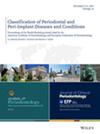Taurine levels in periodontitis: A pilot study
Abstract
Background
Periodontitis is a chronic inflammatory condition that affects the supporting structures of the teeth. It is closely associated with oxidative stress and inflammation. Taurine, a semi-essential amino acid recognized for its antioxidant and anti-inflammatory properties, has not been extensively investigated in the context of periodontitis. This pilot study sought to evaluate the levels of taurine and inflammatory cytokines, including interleukin-1 beta (IL-1β), interleukin-6 (IL-6), and tumor necrosis factor-alpha (TNF-α), in the gingival crevicular fluid (GCF) of individuals with periodontitis.
Methods
Systemically healthy participants with periodontitis and periodontally healthy individuals were enrolled. GCF samples were collected, and clinical periodontal parameters such as bleeding on probing (BOP), clinical attachment loss (CAL), plaque index (PI), and probing depth (PD) were documented. The levels of taurine, TNF-α, IL-1ß, and IL-16 in the GCF were quantified using enzyme-linked immunosorbent assay (ELISA).
Results
This case-control pilot study included 40 individuals, divided into 2 groups: 20 periodontally healthy individuals and 20 with stage III, grade B generalized periodontitis. The periodontitis group exhibited significantly higher clinical periodontal parameters than the healthy group (p < 0.05). Taurine levels in GCF were significantly lower, while TNF-α levels were higher in the periodontitis group (p < 0.05). No significant differences between groups were found in IL-6 and IL-1β levels (p > 0.05). A moderate positive correlation was observed between BOP and TNF-α levels (r = 0.581, p = 0.007).
Conclusions
These findings indicated increased taurine levels were associated with periodontal health.
Plain Language Summary
Periodontitis is a serious disease of the gums that can lead to the loss of teeth by destruction of the supporting tissues. This study investigated the potential link between taurine, a naturally occurring compound with anti-inflammatory properties, and periodontitis. We measured levels of taurine and inflammation-related proteins in gum fluid from individuals with healthy gums and those with periodontitis. Subjects with periodontitis had lower levels of taurine and higher levels of the inflammatory protein TNF-α compared to individuals with healthy gums, suggesting that taurine could be involved in the inflammation processes of periodontitis.




 求助内容:
求助内容: 应助结果提醒方式:
应助结果提醒方式:


